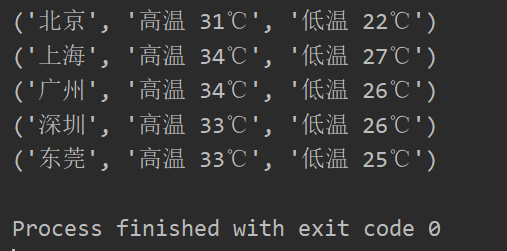8.python3实用编程技巧进阶(三)
3.1.如何实现可迭代对象和迭代器对象
#3.1 如何实现可迭代对象和迭代器对象 import requests from collections.abc import Iterable,Iterator class WeatherIterator(Iterator): def __init__(self,cities): self.cities = cities #从列表中迭代一个city,index就+1 self.index = 0 def __next__(self): #如果所有的城市都迭代完了,就抛出异常 if self.index == len(self.cities): raise StopIteration #当前迭代的city city = self.cities[self.index] #迭代完当前city,index就+1 self.index += 1 return self.get_weather(city) def get_weather(self,city): url = 'http://wthrcdn.etouch.cn/weather_mini?city=' + city r = requests.get(url) #获取当天的天气信息 data = r.json()['data']['forecast'][0] #返回城市名字、最高和最低气温 return city, data['high'], data['low'] class WeatherIterable(Iterable): def __init__(self,cities): self.cities = cities def __iter__(self): return WeatherIterator(self.cities) def show(w): for x in w: print(x) weather = WeatherIterable(['北京','上海','广州','深圳','东莞']) show(weather)
结果

3.2如何使用生成器函数实现可迭代对象
#3.2如何使用生成器函数实现可迭代对象 from collections.abc import Iterable class PrimeNumbers(Iterable): def __init__(self,a,b): self.a = a self.b = b def __iter__(self): for k in range(self.a,self.b): if self.is_prime(k): yield k def is_prime(self,k): return False if k < 2 else all(map(lambda x : k % x, range(2, k))) #打印1到30直接的素数 pn = PrimeNumbers(1, 30) for n in pn: print(n)
3.3.如何进行反向迭代以及如何实现反向迭代
反向迭代
In [75]: l = [1,2,3,4,5] In [76]: for x in l: ...: print(x) ...: 1 2 3 4 5 In [77]: for x in reversed(l): ...: print(x) ...: 5 4 3 2 1
要想实现反向迭代必须实现__reversed__方法
#3.3.如何进行反向迭代以及如何实现反向迭代 class IntRange: def __init__(self,a,b,step): self.a = a self.b = b self.step = step def __iter__(self): t = self.a while t <= self.b: yield t t += self.step def __reversed__(self): t = self.b while t >= self.a: yield t t -= self.step fr = IntRange(1, 10, 2) for x in fr: print(x) print('=' * 30) #反向迭代 for y in reversed(fr): print(y)
3.4.如何对迭代器做切片操作
(1)切片的实质是__getitem__方法
In [9]: l = list(range(10)) In [10]: l[3] Out[10]: 3 In [11]: l.__getitem__(3) Out[11]: 3 In [12]: l[2:6] Out[12]: [2, 3, 4, 5] In [13]: l.__getitem__(slice(2,6)) Out[13]: [2, 3, 4, 5]
(2)打印文件第2~5行
islice能返回一个迭代对象切片的生成器
#3.4.如何对迭代器做切片操作 from itertools import islice f= open('iter_islice') #打印文件的第2~5行内容 for line in islice(f, 1, 5): print(line)
(3)自己实现islice功能
#自己实现一个类似islice的功能 def my_slice(iterable, start, end, step=1): for i, x in enumerate(iterable): if i >= end: break if i >= start: yield x print(list(my_slice(range(1,20), 4, 10))) #[5, 6, 7, 8, 9, 10] from itertools import islice print(list(islice(range(1,20),4, 10))) #[5, 6, 7, 8, 9, 10]
(4)加step
#3.4.如何对迭代器做切片操作 from itertools import islice f= open('iter_islice') #打印文件的第2~5行内容 for line in islice(f, 1, 5): print(line) #自己实现一个类似islice的功能 def my_slice(iterable, start, end, step=1): tmp = 0 for i, x in enumerate(iterable): if i >= end: break if i >= start: if tmp == 0: tmp = step yield x tmp -= 1 print(list(my_slice(range(1,20), 4, 10))) #[5, 6, 7, 8, 9, 10] print(list(my_slice(range(1,20), 4, 10,2))) #[5, 7, 9] from itertools import islice print(list(islice(range(1,20),4, 10))) #[5, 6, 7, 8, 9, 10] print(list(islice(range(1,20),4, 10,2))) #[5, 7, 9]
3.5.如何在一个for语句中迭代多个可迭代对象
计算学生的三科成绩总分,用zip()函数
In [25]: from random import randint In [26]: chinese = [randint(60,100) for _ in range(10)] In [27]: math = [randint(60,100) for _ in range(10)] In [28]: english = [randint(60,100) for _ in range(10)] In [29]: chinese Out[29]: [70, 63, 85, 74, 70, 96, 60, 69, 62, 83] In [30]: math Out[30]: [76, 81, 86, 93, 74, 83, 69, 63, 60, 80] In [31]: english Out[31]: [100, 96, 83, 89, 71, 79, 82, 87, 81, 71] In [32]: t = [] In [33]: for s1, s2, s3 in zip(chinese, math, english): ...: t.append(s1 + s2 +s3) ...: In [34]: t Out[34]: [246, 240, 254, 256, 215, 258, 211, 219, 203, 234]
求三个班级中分数高于90分的总人数,用chain
In [53]: c1 = [randint(60,100) for _ in range(1,10)] In [54]: c2 = [randint(60,100) for _ in range(1,10)] In [55]: c3 = [randint(60,100) for _ in range(1,10)] In [56]: c1 Out[56]: [60, 79, 89, 84, 68, 68, 89, 68, 82] In [57]: c2 Out[57]: [69, 64, 87, 89, 60, 77, 89, 81, 90] In [58]: c3 Out[58]: [80, 92, 64, 73, 68, 84, 97, 71, 65] In [59]: from itertools import chain In [60]: len([ x for x in chain(c1, c2, c3) if x > 90]) Out[60]: 2
posted on 2019-08-19 22:37 zhang_derek 阅读(1137) 评论(0) 编辑 收藏 举报



【推荐】国内首个AI IDE,深度理解中文开发场景,立即下载体验Trae
【推荐】编程新体验,更懂你的AI,立即体验豆包MarsCode编程助手
【推荐】抖音旗下AI助手豆包,你的智能百科全书,全免费不限次数
【推荐】轻量又高性能的 SSH 工具 IShell:AI 加持,快人一步
· .NET Core 中如何实现缓存的预热?
· 从 HTTP 原因短语缺失研究 HTTP/2 和 HTTP/3 的设计差异
· AI与.NET技术实操系列:向量存储与相似性搜索在 .NET 中的实现
· 基于Microsoft.Extensions.AI核心库实现RAG应用
· Linux系列:如何用heaptrack跟踪.NET程序的非托管内存泄露
· TypeScript + Deepseek 打造卜卦网站:技术与玄学的结合
· Manus的开源复刻OpenManus初探
· 三行代码完成国际化适配,妙~啊~
· .NET Core 中如何实现缓存的预热?
· 阿里巴巴 QwQ-32B真的超越了 DeepSeek R-1吗?
2018-08-19 微信小程序实战–集阅读与电影于一体的小程序项目(八)
2018-08-19 微信小程序实战–集阅读与电影于一体的小程序项目(七)
2018-08-19 微信小程序实战–集阅读与电影于一体的小程序项目(六)